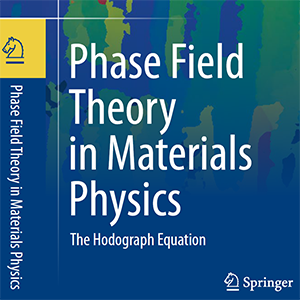Announcements
 A new book by Peter Galenko:
A new book by Peter Galenko:Phase Field Theory in Materials Physics: The Hodograph Equation
RELEASED!
250 Pages. Edition No: 1. 978-3-031-49277-8. Springer, 2024.
Fast Phase Transitions
Fast Phase Transitions (FPT) are initiated due to driving force, which provides velocities of phase boundaries comparable to the atomic diffusion speed or the speed of local structural relaxation [1]. As such, FPT usually exhibit very short time periods for transitive processes. For example, in rapid crystallization of binary alloys [2] one can reach the crystal growth velocity up to 50 (m/s) at the undercooling up to 350 (K). The crystallization time of samples becomes so short that atoms have already no time to exchange their positions and the conditions of local thermodynamic equilibrium (or, in other words, the conditions of thermalization) may not exist.
Generalizing the situation to other processes, one should say that phase transformations proceed very rapidly compared to motion of local chemical or structural disturbance, which has no time enough to relax to its local thermodynamic equilibrium. Examples of such motion or transitions are known in transport processes of non-Newtonian liquids, viscoelastic bodies, rapidly solidifying samples, materials deeply quenched into the spinodal region, and, more generally, systems with memory [3–5].
Atomistically, change of microstates in these specific cases should be described by a non-Markovian master equation which assumes that the processes have not enough time to reach energy or momentum thermalization during rapid phase change or freezing of a highly non-equilibrium system [6, 7]. The non-Markovian approach to FPT and a coarse graining procedure provide a physical basis for evolution and transport equations of the phase field models [8–10]. Phenomenologically, FPT are described using memory kernels, which, in a simplest case of their exponential relaxation, provide a system of hyperbolic partial differential equations for dynamics of interface motion and transport of matter [5, 11, 12].
Local-Nonequilibrium Solidification Model (LNSM) has been introduced for interpretation of phenomena in rapid solidification. Modern experimental techniques and advanced technologies of melting and solidification of metallic and non-metallic systems allow us to reach deep undercoolings, large temperature and concentration gradients, and high velocities of the phase transformations. E.g., in modern experiments the interface velocity reaches 10-100 m/s and the liquid phase can be undercooled in a wide range of 10 to 400 K. Reaching such deep undercoolings leads to large gradients of Gibbs free energy which are considered as a driving force of phase transformations in rapid solidification.
For large driving forces and with increasing velocity of the phase transformation, the solute diffusion field near the rapidly propagating solidification front has no time to completely relax to local thermodynamic equilibrium. A deviation from local thermodynamic equilibrium occurs both in bulk phases and at the interface. As a result, nonequilibrium effects (such as solute trapping, disorder trapping, and solute drag) play a crucial role in formation of metastable or nonequilibrium phases and structures.
At extreme undercooling values, the crystals begin to grow with the initial chemical composition of the liquid in a segregation-free growth mode. In such a case, interface moves with the velocity greater than the solute diffusion speed in bulk phases. This growth mode proceeds by the diffusionless mechanism which occurs in association with morphological transformations of patterns. To describe these effects, LNSM is suggested as a useful theoretical and computational tool for description of pattern formation evolving far from thermodynamic equilibrium.
Bibliography
[1] P. K. Galenko and D. Jou, Rapid solidification as non-ergodic phenomenon, Phys. Rep. 818. P. 1-70.
[2] D. Herlach, P. Galenko, and D. Holland-Moritz, Metastable Solids from Undercooled Melts (Elsevier, Amsterdam, 2007).
[3] G. Lebon, D. Jou, and J. Casas-Vazquez, J. Phys. A 13 , 275 (1980); D. Jou and J. Casas-Vazquez, J. Non-Newtonian Fluid Mech. 96, 77 (2001); G. Lebon, M. Grmela, and D. Lhuillier, J. Non-Equilib. Thermodyn. 28, 1 (2003).
[4] D. Jou, J. Casas-Vazquez, and G. Lebon, Extended Irreversible Thermodynamics, 4th Ed. (Springer, Berlin, 2010).
[5] Galenko P, Jou D. 2005 Diffuse-interface model for rapid phase transformations in nonequilibrium systems. Phys. Rev. E 71, 046125-1-13.
[6] Jou D, Galenko P. 2013 Coarse graining for the phase-field model of fast phase transitions. Phys. Rev. E, 88, 042151-1-8.
[7] Jou D, Galenko P. K. 2018 Coarse-graining for fast dynamics of order parameters in the phase-field model. Phil. Trans. R. Soc. A 376, 20170203-1-.
[8] Galenko PK, Abramova EV, Jou D, Danilov DA, Lebedev VG, Herlach DM. 2011 Solute trapping in rapid solidification of a binary dilute system: a phase-field study. Phys. Rev. E 84, 041143.
[9] Galenko PK, Sanches FI, Elder KR. 2015 Traveling wave profiles for a crystaline front invading liquid states. Physica D 308, 1–10.
[10] P. K. Galenko, V. Ankudinov and I. Starodumov, Fast Dynamics of Phase-Field Crystals (de Gruyter, Berlin, 2018).
[11] P. Galenko, Phys. Lett. A 287, 190 (2001).
[12] P. Galenko and D. Jou, Physica A 388, 3113 (2009); N. Lecoq, H. Zapolsky, and P. Galenko, Eur. Phys. J. ST 177, 165 (2009).
